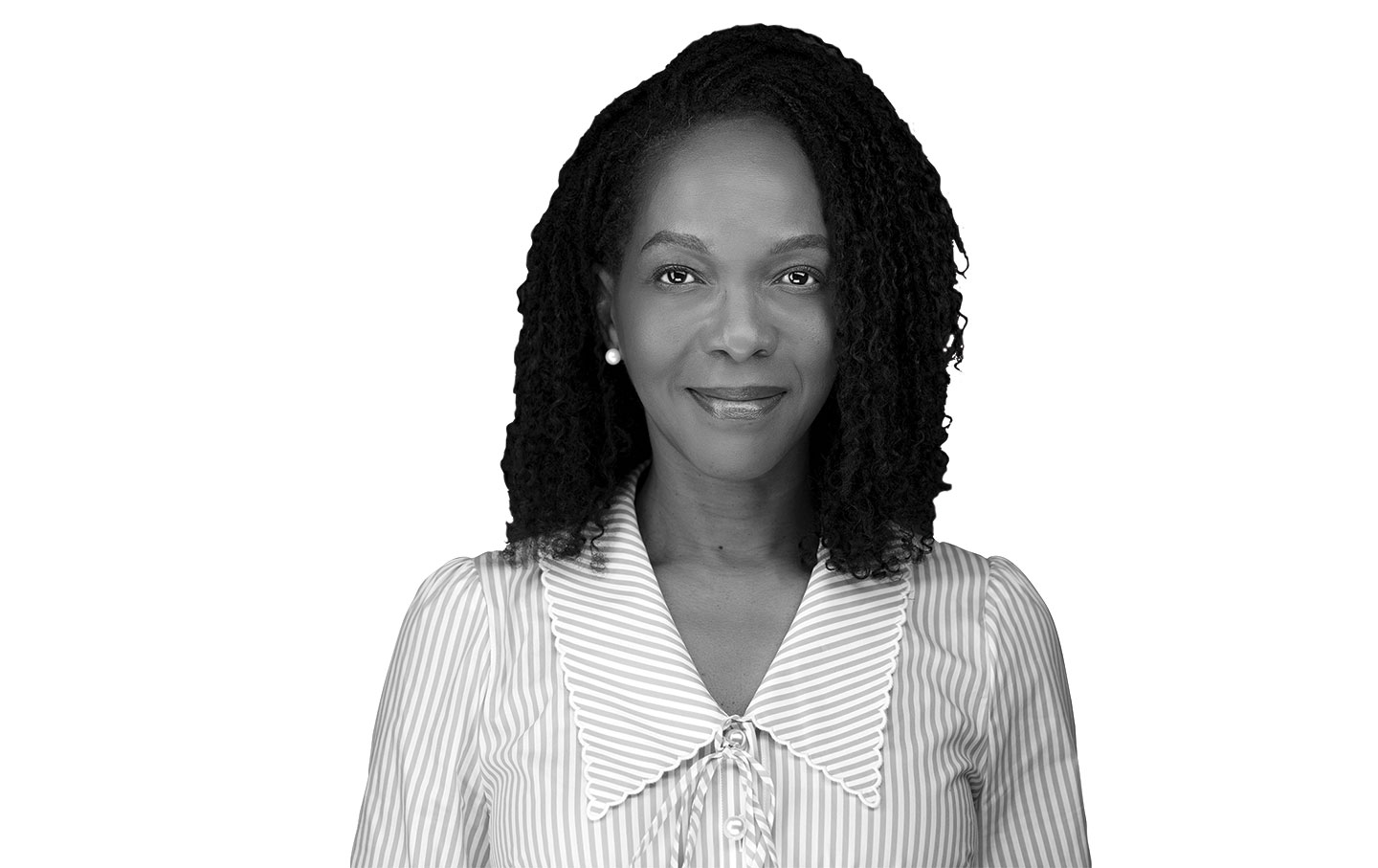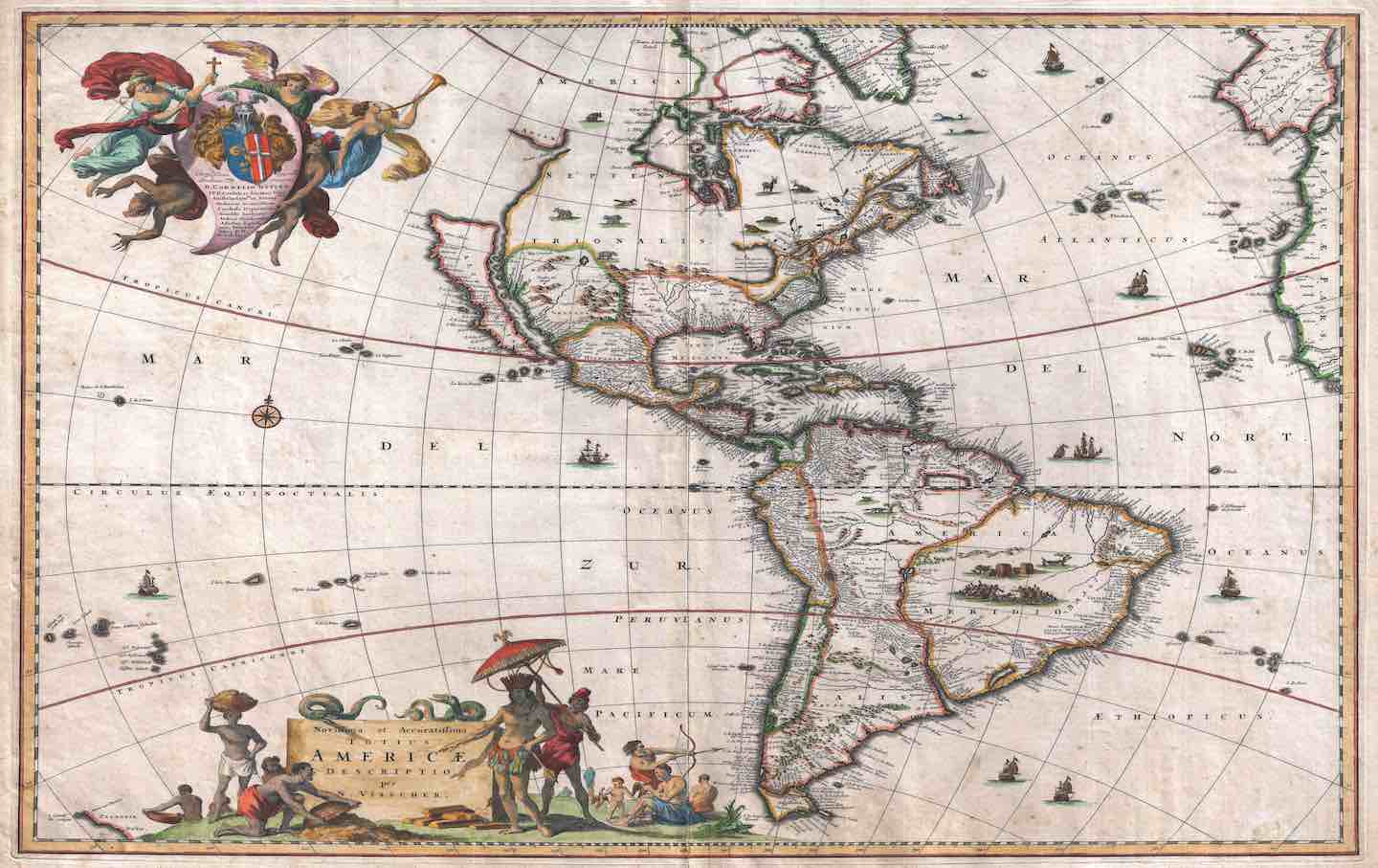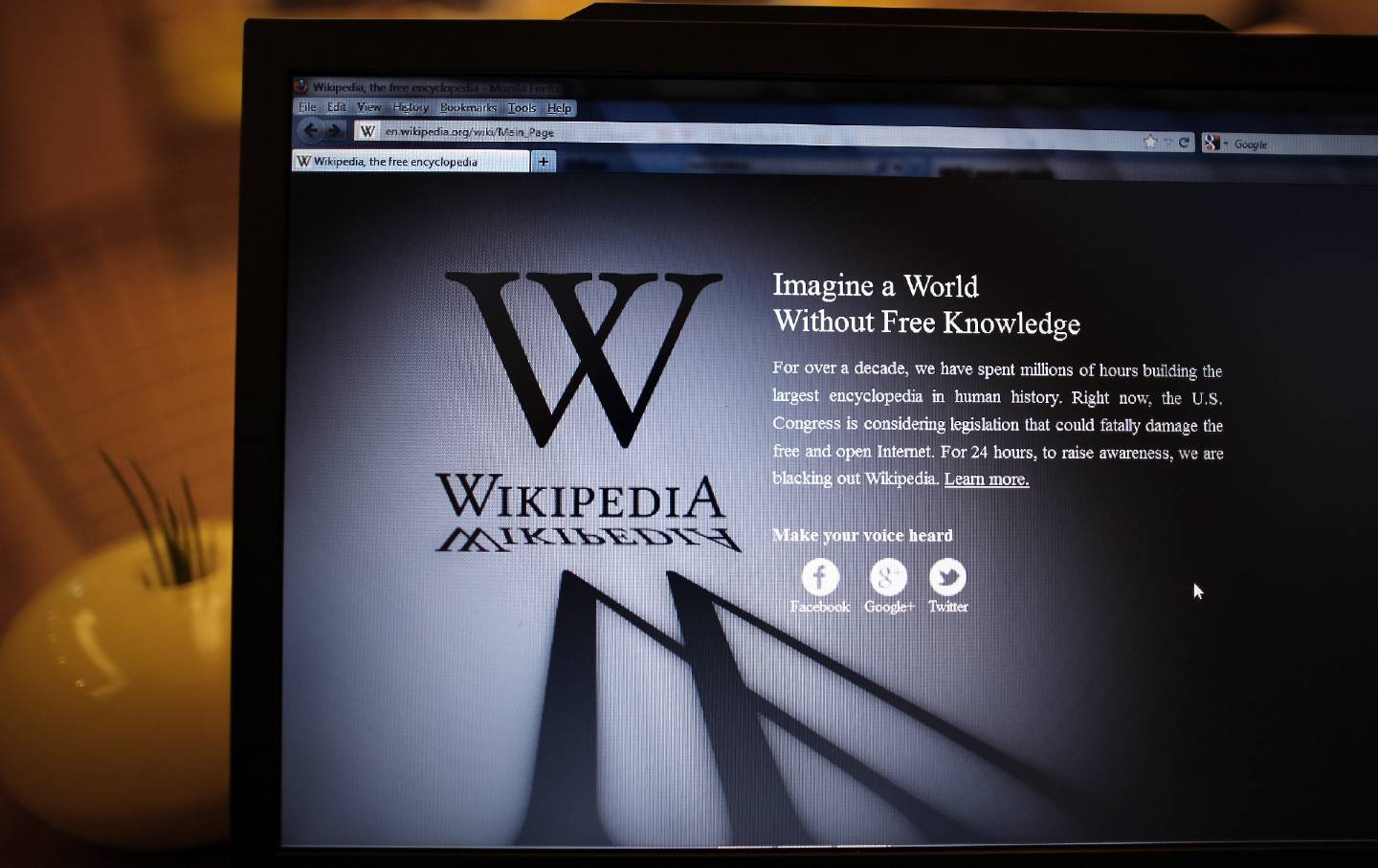“Blues People” and Black Life: A Conversation With Imani Perry
We spoke with the scholar about Black in Blues, a poetic exploration of the relationship between the color blue and Black people.

Although Imani Perry has long chronicled Black life with an expansive eye, her writings since 2018 have covered an especially broad array of subjects. That year, she published a biography of Lorraine Hansberry (Looking for Lorraine); a history of the Black national anthem (May We Forever Stand); and a Black feminist theory of patriarchy (Vexy Thing). Her 2019 book Breathe ruminated on the relationship between Blackness, childhood, and American governance in an epistle to her sons in the style of James Baldwin’s The Fire Next Time. And her 2022 book South to America combined reportage and cultural criticism to profile the region that she dubbed “the soul of the nation.” Whether in books or essays—in straightforward history or formally experimental scholarship—Perry’s writing has detailed Black people’s persistence and thriving in the face of anti-Blackness, economic deprivation, sexism, and other deleterious forces.
Perry’s latest book, Black in Blues: How a Color Tells the Story of My People, chronicles the relationship between the color blue and Black people, whom Amiri Baraka famously dubbed “blues people.” Perry tracks this relationship from the early modern cultivation of indigo in Africa to enslaved people planting periwinkles in lieu of headstones, to the musical genre of the blues and beyond. Whether writing about Toni Morrison’s The Bluest Eye or the street performer Hugh “Brother Blue” Hill, Perry examines in exhilarating detail the investment in and experimentation with the color blue that Black people have long embraced.
The Nation spoke with Perry earlier this year about colors, slavery, jazz, African American literature, and more. This interview has been edited for concision and clarity.
—Elias Rodriques
Elias Rodriques: What led you to write this book now?
Imani Perry: The now is so tricky, because I’ve been working on it for years. I began working on this book and South to America in 2019, but I’ve been focusing on Black in Blues for the last three years, which has been a blues-soaked era. I did not anticipate how much it would be when I was writing the book. But in this moment in history, from climate catastrophe to the ways in which empires are not going down without a fight, to various forms of racism and domination, the blues feel very apt right now.
ER: You write that you wanted to “write toward the mystery of blue and its alchemy in the lives of Black folk.” What is the mystery?
IP: Part of it is the question “Why does the color seem so pervasive and resonant in Black life?” It shows up again and again. That has to do with the blues, with the concept of being “blues people,” and with the blues aesthetic. I didn’t want to just provide a descriptive account of how blue shows up in Black life but to provide a sense of what it means, which has everything to do with the history of Black life.
Before the transatlantic slave trade, the people of Africa were described as varied—they weren’t considered uniform. In West Africa, people cultivated indigo, but indigo captivated the entire world. Blue glass and beads were desirable. There was an aesthetic and beauty to blue that exemplified the things that were common in humanity before the world that the slave trade initiated. Then people were traded for indigo—they went from being cultivators of indigo to being traded for indigo. Blue beads were used as ballast for slave ships, and people were traded for beads. That gives us a sense of the process of becoming “Black people.” The process of becoming categorized racially did not happen in one fell swoop; there were waves of this transition. This meaning-making of race has to do with power and commerce. Even as this transition was happening in waves of encounters that were tragic, people were still trying to figure out how to make some semblance of meaning. Some enslaved people used indigo for forms of spiritual protection.
ER: You also describe “blue-black living” as “bittersweet virtue” and “mastery in heartbreak.” What do you mean by that?
IP: It’s a virtue for people who have been rendered chattel to continue to create beauty and to love and to imagine. In some sense, that’s an insistence upon humanity, a kind of holding on to a depth and complexity of selfness that legal and social accounts deny. That, to me, is a virtue, a kind of spiritual capacity that we need to attend to. It’s not exclusive to Black people, but there’s a lesson to learn in the experience of Black people. It’s the greatest of what human beings can be.
ER: During slavery, you describe blue as related to greed, profit, and violence, even as it exceeds these categories.
IP: This happened in multiple contexts. There were slave ships named the True Blue, after all. But even in the horror of the Middle Passage, through insurrections and various negotiations, it’s not entirely clear that a sense of linked fate had developed amongst African people. There were insurrectionists betrayed by other Africans—even that category didn’t really mean anything in particular to them.
Then, in the Upper South, periwinkle was used to mark grave sites, because gravestones were not given to enslaved people. That’s an indication of a people having some kind of spirit and responsibility in the face of death. It’s not that sociality or rootedness was gone: There was a new ritual, and the ritual was associated with becoming bound to that place. When you bury people in a place and develop distinct rituals, that’s part of what it means to become connected to a location. That practice of finding ways to mark the dead is telling us a story that is blue. Enslaved people continue to want to wear blue, to cultivate indigo, and to paint their porches blue on their own time, even when those people have been enslaved on indigo plantations. This also raises questions about how we ethically attend to the past as thinkers. I can talk about the absence of headstones, but I am more interested in the presence of periwinkles to this day.
ER: And, of course, you follow this story about the color blue into the blues and jazz.
IP: The blues are the core of American music for a reason. The blue note, and the blues as a genre that surrounds it, provides a foundation for jazz. That’s the core that gets improvised with. Sonically, it’s a kind of foundation that gets reworked in different ways in different moments. In the context of the promise of the freedom movement, there are waves of different kinds of experimentation, bolder sound, and more insistence. The music grows with the tide of social and political upheaval, resistance, and expansion. But the melancholy, playing the blues to get over, and the blues sensibility are always there. One step forward, two steps back; three steps forward, two steps back. The music, in some sense, takes on both the possibility and the terrible choreography that are part of the American project. That is in Nina Simone, Miles Davis, and the song “Afro Blue,” among other things. “Afro Blue” offers an entry point to thinking diasporically in an age of both decolonization and the freedom movement. This story takes place in this nation, but there are always arterial connections to other parts of the world, and those connections get reengaged and snuffed out repeatedly. The sound of the blue note captures that.
ER: You describe the “sensibility that lies in the blues” as one of “living as a protest.” What kind of protest does living constitute?
IP: That’s a riff on Lorraine Hansberry. She talked about this with respect to the South Side of Chicago, and the distinction between her own experience in a family of middle-class strivers and the disposition of the folks in her community, for whom the fullness of living was the willingness to confront everything, whether it was with joy or sound or creation. This isn’t protest in the sense of a demonstration, but a refusal of the terms of order in day-to-day living. At another point, I write about it in terms of living in song. The actual disposition to life is not the terms of domination but something much more. It’s at once organic and imaginative and intellectual.
Popular
“swipe left below to view more authors”Swipe →Hansberry told this story about her high school: It was already an integrated school, but they were trying to increase the number of Black students in the school, and there was an episode of mob violence from white students against Black students protesting. The kids from the overwhelmingly Black high school across town heard about it and said, “We have to go over there, because those middle-class kids don’t know how to defend themselves.” Hansberry admired that in poor and working-class Black communities, and she felt that it was disciplined out in bourgeois aspiration.
ER: As the book goes on, the term “self-regard” appears more. What does self-regard mean to you?
IP: I always think of my grandmother when I think of that term. Once, she said to a doctor, who was sort of being dismissive, “I know you don’t care anything about me because I’m old and Black.” He replied, “Oh no, Mrs. Perry, I’m not.” She was being disregarded, but she had absolutely high self-regard and trained us to have it in a way that we were sort of expected to assert it boldly when we were being disregarded. This disposition, to me, seems fundamental to what it meant to be able to wage the freedom movement in the mid-20th century and the like.
Self-regard is different from self-care. It’s not just a matter of tending to oneself but actually making a decision that what you say and think matters and that you ought to be heard. I find it a much more useful term than the more prevalent contemporary term “self-care,” frankly, because it’s care and attention. It’s evident in some of the relationships to the color blue, whether it’s in how people dress or how they adorn their homes. We can see self-regard in the decisions where blue shows up.
ER: This book is a stylistic departure from your other work. What were you after here?
IP: Black in Blues relies upon research but is highly creative in its structure and its organization. Unlike South to America, which was reported in addition to the research, Black in Blues was not reported. But it made sense as part of a creative trajectory. I was trying to do something that I admire in fiction: hold on to the critical intervention, the spiritual dimension, and the emotional, all at the same time. Fiction can talk to people who are having very different conversations in the various realms they occupy. Fiction can be in a conversation on a corner somewhere, in a classroom in another place, and so on. Those conversations are not necessarily the same, but fiction speaks in ways that can channel connections between those different spaces. I was trying to do that with this book.
Thelonious Monk was a constant influence, too. When I first started writing, I was referred to as an elliptical writer. I don’t think that that’s exactly right. I write the way that Monk, in his playing, engages in repetition and then does something that seems like it’s not quite right but turns out to be right. Deliberately falling over and recovering—that aesthetic practice has always been part of what I’m chasing. It’s more musical in nature; it’s the repetitions, riffs, and improvisations of jazz. It’s the work-around. It’s a relation to color and creation that gets reengaged over multiple periods.
ER: Since you’re our expert on Black people’s relationship to the color blue, I’m going to read some quotes with the word blue and ask what comes to mind. Harriet Jacobs, describing her uncle escaping slavery, writes that “he was riding over the blue billows bound for Baltimore.”
IP: In the field of Black studies, we think about the Middle Passage all the time. I am fascinated by the people who got back on the water thinking that there was possibility on the water. And there were so many. Lots of folks got back on the water as a means of escape or traveling. That blue contained both terror and possibility at the same time. And the way she uses language is beautiful. The doubleness of bound in the sense of being captive and going someplace… it’s genius.
ER: Langston Hughes, in Don’t You Want to Be Free: “Blues is what’s the matter when you lose all you got to lose.”
IP: The ambiguity of the language—it’s “what’s the matter” as in “what’s wrong.” It’s also “what’s the matter” as in “what you have.” There’s a lot of talk about words in African American Vernacular English that can mean the opposite: “bad” and “good.” A more nuanced read is that these words function in sentences on multiple registers. We’re talking about crafted works, but that’s part of the language pattern. African American literature communicates conflicting emotions and conflicting ideas.
ER: Terrance Hayes, in “The Blue Terrance”: “The blues will never go out of fashion.”
IP: That’s such a Southern statement, because you can still hear the blues on the radio in the South. It also can’t go out of fashion because it’s actually not just music: It’s an existential space. It’s exhortations, lamentations, and celebration. That mode of existing is not the same as a style of music that goes in and out of fashion. There’s so much capitalism in the fact of a musical genre. Genres are about marketing, in a way. But when you get beyond that—when you think about what the blues are, not simply in terms of a genre but what that style captured and coalesced and what it allowed people to express—it has a permanence. It’s not transient.
ER: This reminds me of that Hortense Spillers line about Black women singers: “She is, in the moment of performance, the primary subject of her own invention.”
IP: That is part of Hortense’s genius: She theorizes at the point of living. That’s how we’re supposed to do theory. When we do it right, it’s born of an observation of the world as it is. She’s theorizing from the material of daily living, moving from that to abstraction rather than beginning with abstraction. The blues singer sings, and that becomes a means of taking ownership of space. That relies upon the senses of others—their sense of hearing—so it all becomes a sense-making exercise. The capturing of senses reconfigures the order of the space: Now you’re on the terms of the sound of this voice. That is a kind of freedom and insistence that transforms the environment.
Hold the powerful to account by supporting The Nation
The chaos and cruelty of the Trump administration reaches new lows each week.
Trump’s catastrophic “Liberation Day” has wreaked havoc on the world economy and set up yet another constitutional crisis at home. Plainclothes officers continue to abduct university students off the streets. So-called “enemy aliens” are flown abroad to a mega prison against the orders of the courts. And Signalgate promises to be the first of many incompetence scandals that expose the brutal violence at the core of the American empire.
At a time when elite universities, powerful law firms, and influential media outlets are capitulating to Trump’s intimidation, The Nation is more determined than ever before to hold the powerful to account.
In just the last month, we’ve published reporting on how Trump outsources his mass deportation agenda to other countries, exposed the administration’s appeal to obscure laws to carry out its repressive agenda, and amplified the voices of brave student activists targeted by universities.
We also continue to tell the stories of those who fight back against Trump and Musk, whether on the streets in growing protest movements, in town halls across the country, or in critical state elections—like Wisconsin’s recent state Supreme Court race—that provide a model for resisting Trumpism and prove that Musk can’t buy our democracy.
This is the journalism that matters in 2025. But we can’t do this without you. As a reader-supported publication, we rely on the support of generous donors. Please, help make our essential independent journalism possible with a donation today.
In solidarity,
The Editors
The Nation








